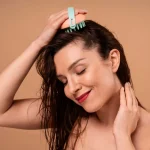Nits, the tiny eggs laid by lice, are a common problem, especially in households with young children. As a parent, discovering these unwelcome guests in your child’s hair can be alarming. You might wonder if common hair tools, like hair straighteners, can help you get rid of them. Let’s explore this idea, see what experts say, and discover the safest and most effective ways to tackle this problem.
What Are Nits?
Nits are the eggs of head lice. They are tiny, about the size of a knot in thread, and are usually yellow or white. Nits are glued to the hair shaft close to the scalp. They are tough and difficult to remove. When they hatch, they become nymphs, which are baby lice. Within a week, these nymphs grow into adult lice, starting the cycle again.
Can Hair Straighteners Kill Nits?
Hair straighteners use high heat to style hair. You might think that this heat could kill nits and lice. However, experts say this method is not effective and can be dangerous.
- Dr. Jessica Helton, a pediatrician and lice expert, explains, “Hair straighteners can potentially kill adult lice with direct contact due to the high heat, but they are unlikely to be effective against nits (lice eggs). Nits have a tough outer shell and may not reach lethal temperatures”.
- Tina Davies, a lice treatment specialist, adds, “Using a hair straightener for lice removal is dangerous and ineffective. The heat can burn the scalp, and it’s nearly impossible to ensure all nits are exposed to enough heat to die.”
- Lisa Richards, a trichologist and hair health expert, points out, “Nits are firmly attached to the hair shaft very close to the scalp. It’s nearly impossible to get a hair straightener close enough to reach lethal temperatures without risking burns.”
Personal Anecdote: My Attempt with Hair Straighteners
I remember when my daughter came home from school scratching her head constantly. After a quick check, I saw those tiny white nits clinging to her hair. I panicked and, without thinking much, reached for my hair straightener. I thought it would be a quick fix. As I tried to run the hot plates through her hair, she squirmed in pain from the heat, and I quickly realized this was not the solution. The nits remained, and I had to look for safer, more effective methods.
Safer Alternatives to Hair Straighteners
Instead of using a hair straightener, consider these safer and more effective methods to treat lice and nits.
Over-the-Counter Medicated Shampoos
Medicated shampoos are specifically designed to kill lice and nits. Maya Ellis, a pharmacist and lice treatment advisor, says, “There are much safer and more effective methods for lice treatment, like over-the-counter medicated shampoos or lice combs. Stick to these proven solutions to avoid harming yourself or your child.”
A study in 2021 reviewed various over-the-counter lice treatment shampoos and found them effective in killing lice and nits.
Lice Combs
Lice combs are an essential tool in removing nits. Marie Mitchell, a lice treatment educator, advises, “Focus on removing nits physically with a lice comb. This is a tedious but safe and effective way to eliminate nits and prevent them from hatching into new lice.”
A 2018 study compared different lice combs and highlighted their importance in physically removing lice and nits.
Professional Lice Treatment Services
Lice clinics offer professional and guaranteed lice removal services. David Williams, a lice clinic owner, and advocate, mentions, “Lice clinics offer professional lice removal services that are guaranteed to be effective. Consider this option for a safe and thorough treatment.”
A 2020 multi-center study showed the high success rates of professional lice treatment services.
Success with a Lice Comb
After my failed attempt with the hair straightener, I bought a good-quality lice comb. Every evening, I sat with my daughter, carefully combing through her hair. It was a slow process, but with each pass, I removed more nits. After about a week of diligent combing, her head was finally clear of nits. It was a relief to find a method that worked without causing her pain.
The Dangers of Using Hair Straighteners for Lice Removal
Using a hair straightener to kill nits is not only ineffective but also dangerous. The high heat required to kill lice can cause burns to the scalp. A 2019 retrospective analysis highlighted the potential dangers of improper use of hair styling tools, including burns from hair straighteners.
Dr. Helton reiterates, “Hair straighteners are not designed to treat lice. The risk of burns and the ineffectiveness in reaching all nits make this method unsuitable.”
Why Nits Are So Tough to Kill
Nits are incredibly resilient. Their tough outer shell protects them from most treatments that can kill adult lice. They are also glued to the hair shaft with a strong, sticky substance, making them difficult to remove.
Lisa Richards explains, “Nits are firmly attached to the hair shaft very close to the scalp. It’s nearly impossible to get a hair straightener close enough to reach lethal temperatures without risking burns.”
Learning the Hard Way
When my son had lice, I initially tried using a hair dryer on high heat, thinking it might work like a hair straightener. Unfortunately, it did not work either, and it was too hot for him. He ended up with a red, irritated scalp, and the nits were still there. That’s when I turned to safer, more effective methods.
Conclusion: The Best Way to Get Rid of Nits
Getting rid of nits requires patience and the right tools. Hair straighteners are not the answer. They are dangerous and ineffective against nits. Instead, use over-the-counter medicated shampoos, lice combs, and consider professional lice treatment services for a guaranteed solution.
Remember, treating lice and nits can be a tedious process, but with the right approach, you can successfully eliminate them without risking burns or other injuries. Stick to proven methods and keep your loved ones safe.




